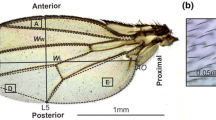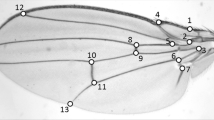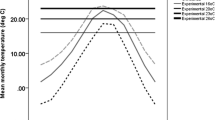Abstract
Fluctuating asymmetry (FA) is often used as a measure of underlying developmental instability (DI), motivated by the idea that morphological variance is maladaptive. Whether or not DI has evolutionary potential is a highly disputed topic, marred by methodological problems and fuzzy prejudices. We report here some results from an ongoing study of the effects of karyotype, homozygosity and temperature on wing form and bilateral asymmetry using isochromosomal lines ofDrosophila subobscura. Our approach uses the recently developed methodologies in geometric morphometrics to analyse shape configurations of landmarks within the standard statistical framework employed in studies of bilateral asymmetries, and we have extended these methods to partition the individual variation and the variation in asymmetries into genetic and environmental causal components. The analyses revealed temperaturedependent expression of genetic variation for wing size and wing shape, directional asymmetry (DA) of wing size, increased asymmetries at suboptimal temperature, and a transition from FA to DA in males as a result of increase in the rearing temperature. No genetic variation was generally detected for FA in our samples, but these are preliminary results because no crosses between lines were carried out and, therefore, the contribution of dominance was not taken into account. In addition, only a subset of the standing genetic variation was represented in the experiments.
Similar content being viewed by others
References
Alvarez G., Martínez P., Zapata C., Santos M. and Fontdevila A. 1981 Genetic analysis of modifier variability inDrosophila subobscura.Experientia 37, 1150–1151.
Balanyá J., Segarra C., Prevosti A. and Serra L. 1994 Colonization of America byDrosophila subobscura: the founder event and a rapid expansion.J. Hered. 85, 427–432.
Balanyá J., Serra L., Gilchrist G. W., Huey R. B., Pascual M., Mestres F. and Solé E. 2003 Evolutionary pace of chromosomal polymorphism in colonizing populations ofDrosophila subobscura: an evolutionary time series.Evolution 57, 1837–1845.
Birdsall K., Zimmerman E., Teeter K. and Gibson G. 2000 Genetic variation for the positioning of wing veins inDrosophila melanogaster.Evol. Dev. 2, 16–24.
Blake W. J., Kaern M., Cantor C. R. and Collins J. J. 2003 Noise in eukaryotic gene expression.Nature 422, 633–637.
Bookstein F. L. 1991Morphometric tools for landmark data: geometry and biology. Cambridge University Press, Cambridge.
Chapman R. E. 1990 Conventional Procrustes approaches. InProceedings of the Michigan Morphometrics Workshop. Spec. Publ. No. 2 (ed. F. J. Rohlf and F. L. Bookstein), pp. 251–267. University of Michigan Museum of Zoology, Ann Arbor.
Cheung V. G., Conlin L. K., Weber T. M., Arcaro M., Jen K.-Y., Morley M. and Spielman R. S. 2003 Natural variation in human gene expression assessed in lymphoblastoid cells.Nat. Genet. 33, 422–425.
Coyne J. A. 1987 Lack of response to selection for directional asymmetry inDrosophila melanogaster.J. Hered. 78, 119.
David J. 1962 A new medium for rearingDrosophila in axenic conditions.Dros. Inf. Serv. 36, 128.
Debat V., Alibert P., David P., Paradis E. and Auffray J.-C. 2000 Independence between developmental stability and canalization in the skull of the house mouse.Proc. R. Soc. London B267, 423–430.
Dryden I. L. and Mardia K. V. 1998Statistical shape analysis. Wiley, Chichester.
Edginton E. S. 1995Randomization tests. Marcel Dekker, New York.
Elowitz M. B., Levine A. J., Siggia E. D. and Swain P. S. 2002 Stochastic gene expression in a single cell.Science 297, 1183–1186.
Fuller R. C. and Houle D. 2003 Inheritance of developmental instability. InDevelopmental instability: causes and consequences (ed. M. Polak), pp. 157–183. Oxford University Press, New York.
Gangestad S. W. and Thornhill R. 1999 Individual differences in developmental precision and fluctuating asymmetry: a model and its implications.J. Evol. Biol. 12, 402–416.
Gilchrist A. S. and Partridge L. 1999 A comparison of the genetic basis of wing size divergence in three parallel body size clines ofDrosophila melanogaster.Genetics 153, 1775–1787.
Gilchrist A. S. and Partridge L. 2001 The contrasting genetic architecture of wing size and shape inDrosophila melanogaster.Heredity 86, 144–152.
Gilchrist A. S., Azevedo R. B. R., Partridge L. and O’Higgins P. 2000 Adaptation and constraint in the evolution ofDrosophila melanogaster wing shape.Evol. Dev. 2, 114–124.
Good P. 1994Permutation tests: a practical guide to resampling methods for testing hypotheses. Springer, New York.
Goodall C. 1991 Procrustes methods in the statistical analysis of shape.J. R. Stat. Soc. B53, 285–339.
Graham J. H., Emlen J. M. and Freeman D. C. 2003 Nonlinear dynamics and developmental instability. InDevelopmental instability: causes and consequences (ed. M. Polak), pp. 35–50. Oxford University Press, New York.
Hoffmann A. A. and MerilÄ J. 1999 Heritable variation and evolution under favourable and unfavourable conditions.Trends Ecol. Evol. 14, 96–101.
Houle D. 1997 Comment on ’A metaanalysis of the heritability of developmental stability’ by MØller and Thornhill.J. Evol. Biol. 10, 17–20.
Houle D. 2000 A simple model of the relationship between asymmetry and developmental stability.J. Evol. Biol. 13, 720–730.
Jolliffe I. T. 1986Principal component analysis. Springer, New York.
Klingenberg C. P. 2003a A developmental perspective on developmental instability: theory, models, and mechanisms. InDevelopmental instability: causes and consequences (ed. M. Polak), pp. 14–34. Oxford University Press, New York.
Klingenberg C. P. 2003b Developmental instability as a research tool: using patterns of fluctuating asymmetry to infer the developmental origins of morphological integration. InDevelopmental instability: causes and consequences (ed. M. Polak), pp. 427–442. Oxford University Press, New York.
Klingenberg C. P. and Leamy L. J. 2001 Quantitative genetics of geometric shape in the mouse mandible.Evolution 55, 2342–2352.
Klingenberg C. P. and McIntyre G. S. 1998 Geometric morphometrics of developmental instability: analysing patterns of fluctuating asymmetry with Procrustes methods.Evolution 52, 1363–1375.
Klingenberg C. P. and Nijhout H. F. 1999 Genetics of fluctuating asymmetry: A developmental model of developmental instability.Evolution 53, 358–375.
Klingenberg C. P. and Zaklan S. D. 2000 Morphological integration between developmental compartments in theDrosophila wing.Evolution 54, 1273–1285.
Klingenberg C. P. and Zimmermann M. 1992 Static, ontogenetic, and evolutionary allometry: a multivariate comparison in nine species of water striders.Am. Nat. 140, 601–620.
Klingenberg C. P., McIntyre G. S. and Zaklan S. D. 1998 Leftright asymmetry of fly wings and the evolution of body axes.Proc. R. Soc. London B265, 1255–1259.
Klingenberg C. P., Barluenga M. and Meyer A. 2002 Shape analysis of symmetric structures: quantifying variation among individuals and asymmetry.Evolution 56, 1909–1920.
Koske Th. and Maynard Smith J. 1954 Genetics and cytology ofDrosophila subobscura. X. The fifth linkage group.J. Genet. 52, 521–541.
Krimbas C. B. and Loukas M. 1980 The inversion polymorphism ofDrosophila subobscura.Evol. Biol. 12, 163–234.
Lankinen P. and Pinsker W. 1977 Allozyme constitution of standard strains ofDrosophila subobscura.Experientia 33, 1301.
Leamy L. 1999 Heritability of directional and fluctuating asymmetry for mandibular characters in randombred mice.J. Evol. Biol. 12, 146–155.
Leamy L. J., Routman E. J. and Cheverud J. M. 1997 A search for quantitative trait loci affecting asymmetry of mandibular characters in mice.Evolution 51, 957–969.
Leamy L. J., Pomp D., Eisen E. J. and Cheverud J. M. 2000 Quantitative trait loci for directional but not fluctuating asymmetry of mandible characters in mice.Genet. Res. 76, 27–40.
Leary R. F. and Allendorf F. W. 1989 Fluctuating asymmetry as an indicator of stress: implications for conservation biology.Trends Ecol. Evol. 4, 214–217.
Leibowitz A., Santos M. and Fontdevila A. 1995 Heritability and selection on body size in a natural population ofDrosophila buzzatii.Genetics 141, 181–189.
Leung B. and Forbes M. R. 1997 Modelling fluctuating asymmetry in relation to stress and fitness.Oikos 78, 397–405.
Ligoxygakis P., Strigini M. and Averof M. 2001 Specification of leftright asymmetry in the embryonic gut ofDrosophila.Development 128, 1171–1174.
Loeschcke V., Bundgaard J. and Barker J. S. F. 1999 Reaction norms across and genetic parameters at different temperatures for thorax and wing size traits inDrosophila aldrichi andD. buzzatii.J. Evol. Biol. 12, 605–623.
Loeschcke V., Bundgaard J. and Barker J. S. F. 2000 Variation in body size and life history traits inDrosophila aldrichi andD. buzzatii from a latitudinal cline in eastern Australia.Heredity 85, 423–433.
Lynch M. and Walsh B. 1998Genetics and analysis of quantitative traits. Sinauer, Sunderland.
Mardia K. V., Bookstein F. L. and Moreton I. J. 2000 Statistical assessment of bilateral symmetry of shapes.Biometrika 87, 285–300.
Markow T. A. 1995 Evolutionary ecology and developmental instability.Annu. Rev. Entomol. 40, 105–120.
Mather K. 1953 Genetic control of stability in development.Heredity 7, 297–336.
Maynard Smith J. and Sondhi K. C. 1960 The genetics of a pattern.Genetics 45, 1039–1050.
The MathWorks, Inc. 2000Statistics toolbox for use with MATLAB, V.3 (URL: http://www.mathworks.com).
The MathWorks, Inc. 2002MATLAB, V.6. The language of technical computing (URL: http://www.mathworks.com).
Menozzi P. and Krimbas C. B. 1992 The inversion polymorphism ofDrosophila subobscura revisited: synthetic maps of gene arrangement frequencies and their interpretation.J. Evol. Biol. 5, 625–641.
Mestres F., Balanyá J., Segarra C., Prevosti A. and Serra L. 1992 Colonization of America byDrosophila subobscura: analysis of the O5 inversions from Europe and America and their implications for the colonizing process.Evolution 46, 1564–1568.
MØller A. P. and Swaddle J. P. 1997Asymmetry, developmental stability, and evolution. Oxford University Press, Oxford.
Needham J. 1950Biochemistry and morphogenesis, 2nd edition. Cambridge University Press, Cambridge.
Nijhout H. F. and Davidowitz G. 2003 Developmental perspectives on phenotypic variation, canalization, and fluctuating asymmetry. InDevelopmental instability: causes and consequences (ed. M. Polak), pp. 3–13. Oxford University Press, New York.
Palmer A. R. 1994 Fluctuating asymmetry: a primer. InDevelopmental instability: its origins and evolutionary implications (ed. T. A. Markow), pp. 335–354. Kluwer Academic, Dordrecht (a PDF version with corrections is available via http://www.biology.ualberta.ca/old_site/palmer.hp/PubList.ht m#publications).
Palmer A. R. and Strobeck C. 1986 Fluctuating asymmetry: measurement, analysis, patterns.Annu. Rev. Ecol. Syst. 17, 391–421.
Palmer A. R. and Strobeck C. 1992 Fluctuating asymmetry as a measure of developmental stability: Implications of nonnormal distributions and power of statistical tests.Acta Zool. Fenn. 191, 55–70.
Palmer A. R. and Strobeck C. 2003 Fluctuating asymmetry analyses revisited. InDevelopmental instability: causes and consequences (ed. M. Polak), pp. 279–319. Oxford University Press, New York.
Palmer A. R., Strobeck C. and Chippindale A. K. 1993 Bilateral variation and the evolutionary origin of macroscopic asymmetries.Genetica 89, 201–218.
Pascual M., Aquadro C. F., Soto V. and Serra L. 2001 Microsatellite variation in colonizing and Palearctic populations ofDrosophila subobscura.Mol. Biol. Evol. 18, 731–740.
Pfriem P. 1983 Latitudinal variation in wing size inDrosophila subobscura and its dependence on polygenes of chromosome O.Genetica 61, 221–232.
Polak M. (ed.) 2003Developmental instability:causes and consequences. Oxford University Press, New York.
Powell J. R. 1997Progress and prospects in evolutionary biology. The Drosophila model. Oxford University Press, New York.
Prevosti A., García M. P., Serra L., Aguadé M., Ribó G. and Sagarra E. 1983 Association between allelic isozyme alleles and chromosomal arrangements in European populations and Chilean colonizers ofD. subobscura.Isozymes 10, 171–191.
Prevosti A., Serra L., Ribó G., Aguadé M., Sagarra M., MonclÚs M. and García M. P. 1985 The colonization ofDrosophila subobscura in Chile. II. Clines in the chromosomal arrangements.Evolution 39, 838–844.
Prevosti A., Ribó G., Serra L., Aguadé M., Balanyá J., MonclÚs M. and Mestres F. 1988 Colonization of America byDrosophila subobscura: experiment in natural populations that supports the adaptive role of chromosomal-inversion polymorphism.Proc. Natl. Acad. Sci. USA 85, 5597–5600.
Rao C. V., Wolf D. M. and Arkin A. P. 2002 Control, exploitation and tolerance of intracellular noise.Nature 220, 231–237.
Rodrĺguez-Trelles F. and Rodríguez M. A. 1998 Rapid microevolution and loss of chromosomal diversity inDrosophila in response to climate warming.Evol. Ecol. 12, 829–838.
Rodríguez-Trelles F., Alvarez G. and Zapata C. 1996 Timeseries analysis of seasonal changes of the O inversion polymorphism ofDrosophila subobscura.Genetics 142, 179–187.
Roff D. A. and Mousseau T. A. 1987 Quantitative genetics and fitness: lessons fromDrosophila.Heredity 58, 103–118.
Rohlf F. J. 1990 Rotational fit (Procrustes) methods. InProceedings of the Michigan Morphometrics Workshop. Spec. Publ. No. 2 (ed. F. J. Rohlfand F. L. Bookstein), pp. 2227–2236. University of Michigan Museum of Zoology, Ann Arbor.
Rohlf F. J. 1999 Shape statistics: Procrustes superimpositions and tangent spaces.J. Classif. 16, 197–223.
Rohlf F. J. 2000 Statistical power comparisons among alternative morphometric methods.Am. J. Phys. Anthropol. 111, 463–478.
Rohlf F. J. and Slice D. 1990 Extensions of the Procrustes method for the optimal superimposition of landmarks.Syst. Zool. 39, 40–59.
Santos M. 2001 Fluctuating asymmetry is nongenetically related to mating success inDrosophila buzzatii.Evolution 55, 2248–2256.
Santos M. 2002 Genetics of wing size asymmetry inDrosophila buzzatii.J. Evol. Biol. 15, 720–734.
Santos M., Fernández Iriarte P., Céspedes W., Balanyá J., Fontdevila A. and Serra L. 2004 Swift laboratory thermal evolution of wing shape (but not size) inDrosophila subobscura and its relationship with chromosomal inversion polymorphism.J. Evol. Biol. (in press).
Slice D. E., Bookstein F. L., Marcus L. F. and Rohlf F. J. 1996 A glossary for geometric morphometrics. InAdvances in morphometrics (ed. L. F. Marcus, M. Corti, A. Loy, G. J. P. Naylor and D. E. Slice), pp. 531–551. Plenum, New York (URL: http://life.bio.sunysb.edu/morph).
Sokal R. R. and Rohlf F. J. 1981Biometry, 2nd edition. Freeman, New York.
Sperlich D., Feuerbach-Mravlag H., Lange P., Michaelidis A. and Pentzos-Daponte A. 1977 Genetic load and viability distribution in central and marginal populations ofDrosophila subobscura.Genetics 86, 835–848.
SPSS, Inc. 2001 SPSS for Windows (URL: http://www.spss.com).
StatSoft, Inc. 2003 STATISTICA (data analysis software system), version 6 (URL: http://www.statsoft.com).
Swain P. S., Elowitz M. B. and Siggia E. D. 2002 Intrinsic and extrinsic contributions to stochasticity in gene expression.Proc. Natl. Acad. Sci, USA 99, 12795–12800.
Tuinstra E. J., de Jong G. and Scharloo W. 1990 Lack of response to family selection for directional asymmetry inDrosophila melanogaster: Left and right are not distinguished in development.Proc. R. Soc. London B241, 146–152.
Van Dongen S. 1998 How repeatable is the estimation of developmental stability by fluctuating asymmetry?Proc. R. Soc. London B265, 1423–1427.
Van Dongen S., Sprengers E. and Löfstedt C. 1999 Correlated development, organismwide asymmetry and patterns of asymmetry in two moth species.Genetica 105, 81–91.
Van Dongen S., Lens L. and Molenberghs G. 2003 Recent developments and shortcomings in the analysis of individual asymmetry: a review and introduction of a Bayesian statistical approach. InDevelopmental instability: causes and consequences (ed. M. Polak), pp. 320–342. Oxford University Press, New York.
Van Valen L. 1962 A study of fluctuating asymmetry.Evolution 16, 125–142.
Waddington C. H. 1957The strategy of the genes. Allen & Unwin, London.
Waddington C. H. 1961 Genetic assimilation.Adv. Genet. 10, 257–293.
Walker J. A. 2000 Ability of geometric morphometric methods to estimate a known covariance matrix.Syst. Biol. 49, 686–696.
Wallace B. 1981Basic population genetics. Columbia University Press, New York.
Weber K. E. 1990 Artificial selection on wing allometry inDrosophila melanogaster.Genetics 126, 975–989.
Weber K. E. 1992 How small are the smallest selectable domains of form?Genetics 130, 345–353.
Weber K., Eisman R., Morey L., Patty A., Sparks J., Tausek M. and Zeng Z.-B. 1999 An analysis of polygenes affecting wing shape on chromosome 3 inDrosophila melanogaster.Genetics 153, 773–786.
Weber K., Eisman R., Higgins S., Morey L., Patty A., Tausek M. and Zeng Z.-B. 2001 An analysis of polygenes affecting wing shape on chromosome 2 inDrosophila melanogaster.Genetics 159, 1045–1057.
Whitlock M. C. 1996 The heritability of fluctuating asymmetry and the genetic control of developmental stability.Proc. R. Soc. London B263, 849–854.
Whitlock M. C. 1998 The repeatability of fluctuating asymmetry: a revision and extension.Proc. R. Soc. London B265, 1428–1430.
Woolf C. M. and Markow T. A. 2003 Genetic models for developmental homeostasis: historical perspectives. InDevelopmental instability: causes and consequences (ed. M. Polak), pp. 99–115. Oxford University Press, New York.
Zimmerman E., Palsson A. and Gibson G. 2000 Quantitative trait loci affecting components of wing shape inDrosophila melanogaster.Genetics 155, 671–683.
Author information
Authors and Affiliations
Corresponding author
Rights and permissions
About this article
Cite this article
Iriarte, P.F., Céspedes, W. & Santos, M. Quantitative-genetic analysis of wing form and bilateral asymmetry in isochromosomal lines ofDrosophila subobscura using Procrustes methods. J Genet 82, 95–113 (2003). https://doi.org/10.1007/BF02715812
Issue Date:
DOI: https://doi.org/10.1007/BF02715812




